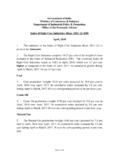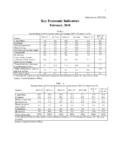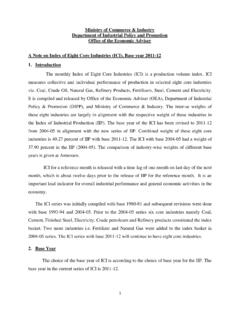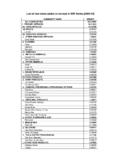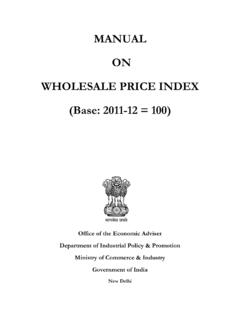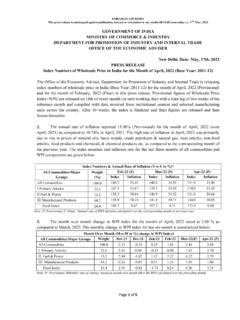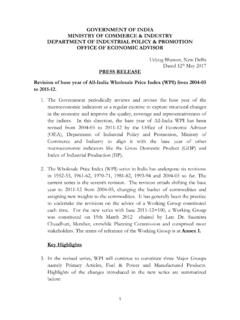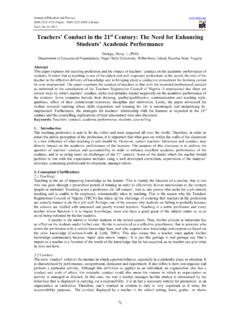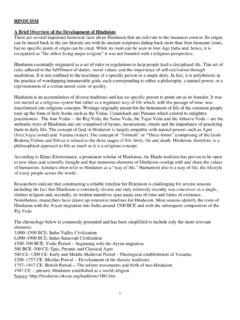Transcription of District Development Plan- Varanasi
1 2019 District Development plan - Varanasi INDIAN INSTITUTE OF MANAGEMENT LUCKNOW Phone: 0522-6696001 Final Report January 2019 Submitted to: Office of Economic Advisor, Department of Industrial Policy and Promotion, Ministry of Commerce and Industries Submitted by: Indian Institute of Management Lucknow Authors: P a g e | i Table of Contents Executive Summary .. 1 Chapter 1 .. 11 Overview .. 11 Introduction .. 11 Objectives .. 11 Scope /Coverage and Methodology.
2 12 Chapter 2 .. 16 Baseline Profile .. 16 About .. 16 Location and Geographical areas .. 16 Climatic Condition .. 18 Demographic details .. 18 Working Population .. 18 Administrative Profile .. 19 Economic Profile of the District .. 19 Chapter 3 .. 27 Sector wise Analysis .. 27 Primary Sector .. 29 Secondary sectors .. 31 Tertiary Sector .. 32 Overall Analysis of the sectors using BCG matrix .. 34 Short listing of Key sectors for GDP growth .. 39 Chapter 4 .. 40 Detailed analysis of selected sectors/components, products or economic activity.
3 40 Silk Products .. 40 Glass beads .. 46 49 Agriculture and Horticulture crops .. 53 Dairy and Livestock .. 58 Fisheries .. 63 Carving on wood and stone .. 67 Metal Repoisse .. 70 P a g e | ii Promising sector with potential for growth in the long term .. 72 Chapter 5 .. 73 Recommendation .. 73 Silk Products .. 73 Glass Beads .. 74 75 Agriculture and Horticulture Crops .. 76 Fisheries .. 77 Dairy and Livestock .. 77 Carving on wood and stone .. 78 Metal Repoisse.
4 79 Common action plan to support the promising sectors of readymade garments and polyester weaving .. 79 List of Tables .. 80 List of figures .. 82 List of Abbreviation .. 83 References .. 84 Appendices .. 86 P a g e | 1 Executive Summary Varanasi (or Benares, Banaras, Kashi), on the left bank of the Ganges, is one of the seven sacred cities of the Hindus. Among the oldest continuously inhabited cities in the world , its early history is that of the first Aryan settlement in the middle Ganges valley.
5 By late 2nd millennium BCE, Varanasi was a seat of Aryan religion and philosophy and a commercial and industrial centre famous for its muslin and silk fabrics, perfumes, ivory works, and sculpture. The capital of the kingdom of Kashi during the time of the Buddha (6th century BCE), who gave his first sermon at nearby Sarnath, it remained a centre of religious, educational, and artistic activities as attested by the celebrated Chinese traveler Hs an-tsang, who visited it in 635 BCE.
6 Even now, there is a progressive trends observed in the tourist influx from the Buddhist circuit thus carrying the rich tourism legacy forward. A centre of arts and crafts, it is also famous for its production of silks and brocades with gold and silver threadwork, as well as for wooden toys, bangles made of glass, ivory work, and brassware. The recognition as Geographical Indicators (GIs) of the region which came to fore in the year 2009 with Banaras brocades and Sarees has further increased the economic and aesthetic value of the place.
7 The District comprises of two tehsils, Varanasi and Pindara respectively at the time of Census 2011. Total area of the District is sq. km. The rural area covers sq. km and urban recorded sq. km. There are eight community Development blocks (Vikas Khand) in the District , namely Baragaon, Pindara, Cholapur Harhua, Sevapuri, Arajiline, Kashi Vidyapith and Chiraigaon. There are 702 Gram Sabhas and 1295 villages in the District , out of which 431 in Pindara tehsil and 864 in Varanasi tehsil.
8 Total numbers of inhabited villages are 1258 in the District to say separately 423 in Pindara tehsil and 835 in Varanasi tehsil. In Census 2011 the District covered 5 statutory Towns and 34 census towns. Out of 5 statutory, Maruadih Railway Settlement is notified as Industrial Township. Varanasi Nagar Nigam (Municipal Corporation), is identified as one of the Mahanagars of Findings Primary Sector: The significant findings in the Primary sector are as follows: (a) Agriculture is the main occupation in Varanasi and is dominated by small and marginal land holdings.
9 Sugarcane, rice and wheat are the main crops of the District accounting for the major portion of the gross area sown. Sorghum and Maize is also grown in the region. The overall agricultural land use in Varanasi (for the year 2014-2015) comprises of the sown area of 95700 hectare. Out of the sown area 62123 hectares is sown more than once. In horticulture practices, marigold flower is widely grown in the region, which is used in the religious offerings. P a g e | 2 (b) Fisheries: The community fishing is dominant.
10 The private sector representation in the fishery sector is negligible in the region. The culture system named Recirculatory Aquaculture System (RAS) is becoming more popular in the region and the practice of natural riverine fisheries is declining. Owing to huge demand, the RAS system should be encouraged and the untapped resources present in the form of unleased community ponds must also be brought under fisheries. (c) Livestock: The breeding of the local cow Ganga Tiri is dominant in the region as the breed symbolises sacred Ganga.

